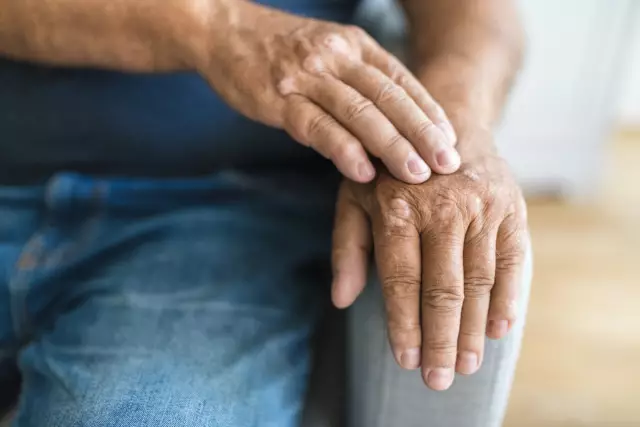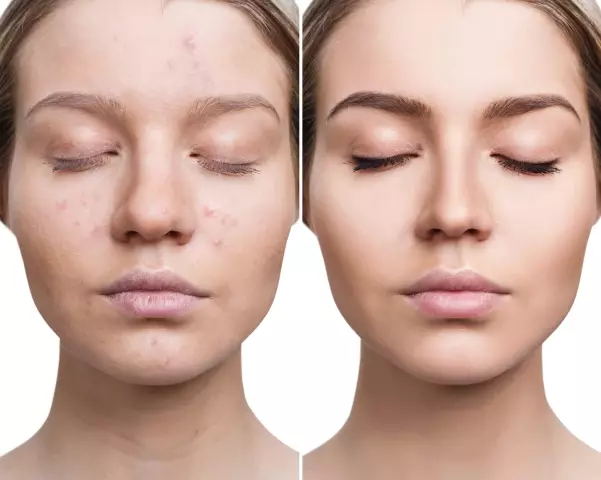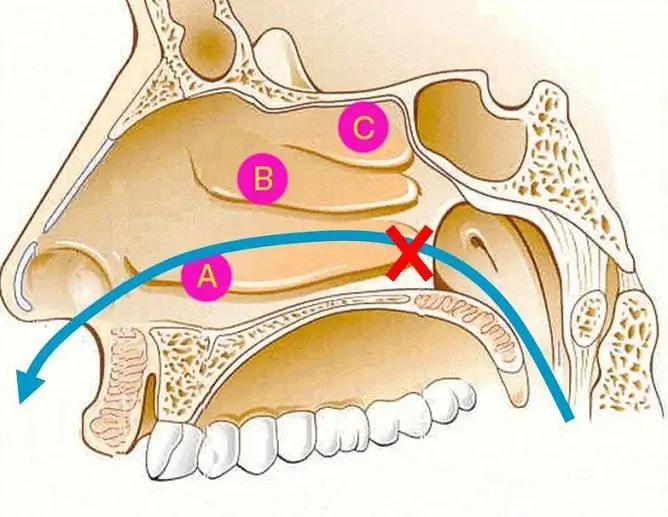- Author Rachel Wainwright [email protected].
- Public 2023-12-15 07:39.
- Last modified 2025-11-02 20:14.
Treatment of medication rhinitis
The content of the article:
- Causes and mechanism of development of pathology
- Symptoms of medication rhinitis
- Diagnosis and treatment of medication rhinitis
- Complications
- Prevention
- Video
What is rhinitis medicamentosa? What are the main reasons for its development? How is the disease characterized? What are the most effective treatments for rhinitis medication?

The development of medicinal rhinitis is associated with prolonged use of vasoconstrictor nasal drops
Rhinitis medication is a type of rhinitis that occurs as a result of prolonged or frequent use of vasoconstrictors (decongestants), which leads to chemical damage to the nasal mucosa. For this reason, the disease can develop in both adults and children.
ICD-10 code: J30 - vasomotor and allergic rhinitis.
Causes and mechanism of development of pathology
The nasal cavity is covered with a layer of cavernous tissue, which can rapidly increase in size with significant filling with blood. In this case, the rate of warming up of the inhaled air increases. After a person enters a warm room, heating is no longer required, so the tissues return to their normal state.

The action of decongestants is aimed at forced narrowing of the capillaries of the nasal cavity
The vasoconstrictor drops affect the capillaries of the nasal cavity, forcibly squeezing them, regardless of the air temperature. The nervous system does not recognize the command and causes the vessels to dilate, causing swelling and nasal congestion.
Reactive hyperemia, which develops several hours after topical administration of α-adrenergic agonists, forces the patient to use these drugs more and more often. This leads to the occurrence of reactive hyperplasia of the mucous membrane and impaired vasomotor function.
The more often vasoconstrictor agents are used, the stronger the swelling of the nasal mucosa. In some cases, a patient who is addicted to drops uses a bottle of the drug per day.
In rare cases, the cause of the development of a drug-induced rhinitis in adults can be the use of drugs of the following groups:
- sympatholytics (Adelfan);
- α-blockers (Doxazosin, Prazosin);
- adrenergic agonists (Methyldopa, Clonidine).
These drugs are used to treat hypertension or adrenal tumors. The drugs act on the nasal mucosa and cause the cavernous epithelium to swell.
In 2-3 months after the start of taking these drugs, the same side effects occur as with vasoconstrictor therapy.
Symptoms of medication rhinitis
Medicinal rhinitis is characterized by the following symptoms:
- a constant feeling of nasal congestion, which disappears only after the use of vasoconstrictors;
- violation or complete absence of smell;
- itching and burning in the nose;
- the appearance of night snoring;
- sleep disorders;
- severe nasal discharge (in some cases).
Diagnosis and treatment of medication rhinitis
If symptoms of the disease are detected, it is necessary to seek advice from an otolaryngologist. The doctor examines the nasal mucosa using an endoscope or rhinoscope. In doing so, he can reveal the following defects in the nasal mucosa:
- severe swelling resulting from a violation of capillary permeability;
- the absence of many ciliated cilia on the surface of epithelial tissue;
- an increase in the volume of the glands resulting from the excessive production of mucous secretions;
- transformation of epithelial tissues.

To diagnose the disease and prescribe treatment, you must contact the ENT
For an objective assessment of the depth of the lesion, additional research methods may be prescribed.
Treatment of medicinal rhinitis is the most difficult task, since the self-regeneration of the mucous membrane takes a long period of time, attempts to stop using decongestants usually do not lead to the desired result.
How to treat medication rhinitis with pharmacological agents? Corticosteroids are most commonly prescribed. These are hormonal medications that can help relieve withdrawal symptoms, reduce inflammation and reduce swelling. They do not have a systemic effect, the active components are deposited on the surface of the nasal mucosa and are practically not absorbed into the bloodstream.
The most effective drugs in this case are drugs based on mometasone (Avamis, Nasonex). On average, they are prescribed a course of 30 days. This avoids the use of decongestants. In some cases, drugs based on fluticasone (Flixonase) are used, but they are considered less effective.
In combination with these drugs, antihistamines (antiallergic drugs) may be prescribed. They can help reduce swelling and nasal discharge.
If within a month the patient's condition does not improve and nasal breathing is not restored, then the treatment must be stopped. In this case, a surgical operation is indicated. The following methods can be assigned:
- cauterization with a laser. Radiation is applied to the nasal mucosa, as a result of which the vessels are compressed and the edema is eliminated. The procedure is performed under local anesthesia. The recovery period is on average 3 weeks. The effect of treatment lasts for several years, and in some cases for life;
- ultrasonic disintegration. With the help of ultrasound, capillaries that have lost their ability to contract are destroyed. Subsequently, the formation of new vessels occurs, functioning normally. The procedure is performed under local anesthesia. The next day, the affected area is treated with drugs that accelerate regeneration and eliminate the inflammatory process. Nasal breathing is restored after a few days.
In the initial stages, you can get rid of a medication rhinitis yourself. This will require willpower and perseverance, since the withdrawal process is quite difficult. Doctor Komarovsky advises to treat the disease by abruptly refusing to use vasoconstrictor drugs. After that, within four days, the vessels will partially restore their functions.
If it is not possible to completely abandon the use of decongestants, you can use a sparing method using drugs with a lower concentration of the active substance (children's forms). Also, the tool can be pre-diluted with saline or only one nostril can be instilled in the solution. The interval between drops should be as long as possible.

Aloe juice can be used to increase the effectiveness of treatment
You can completely get rid of addiction at home 2-3 weeks after giving up decongestants. The following folk remedies can be used to increase effectiveness:
- aloe juice. In order to prepare a remedy based on this plant, the leaves must first be cut off and placed in the refrigerator for a week. Then they are crushed, and the resulting juice is mixed with water. 2-3 drops are dripped into each nasal passage 3-4 times a day;
- onion juice. A medium-sized onion is crushed and squeezed out of juice, which is mixed with the same amount of hot corn oil. After the product has cooled, it is placed in a glass container and stored in the refrigerator. Apply one drop to each nostril in the morning and evening;
- chamomile infusion. A pinch of dried flowers is brewed with boiling water and filtered after cooling. Buried in the nose up to five times a day.
Complications
If you ignore the symptoms of the disease and do not start treatment on time, the following complications may develop:
- lack of nasal breathing;
- severe chronic headaches associated with oxygen deprivation;
- violation of the sense of smell;
- memory impairment arising from hypoxia;
- arterial hypertension;
- immunity disorders;
- sleep problems;
- frequent colds.
With prolonged use of vasoconstrictor agents, the patient develops snoring and respiratory arrest during sleep (apnea). Often, patients with addiction develop arrhythmia, tachycardia, and the functioning of the nervous and endocrine systems.
With the timely start of treatment, the prognosis of the disease is favorable. You can completely get rid of addiction within 1-2 months.
Prevention
In order to avoid the development of medicinal rhinitis, before using drops with a vasoconstrictor component, you should carefully study the instructions. It is important to follow the recommended dosage and not exceed the indicated duration of use.
Before using decongestants, you need to try to cure a runny nose with the help of other medicines, inhalation or rinsing the nose with decoctions of herbs and saline solutions.
In the future, after getting rid of addiction, you should abandon the use of vasoconstrictor drops in order to avoid the development of pathology again.
For the prevention of rhinitis, you need to ventilate the room more often and regularly wet cleaning. It is also recommended to lead a healthy lifestyle, strengthen the immune system.
Video
We offer for viewing a video on the topic of the article.

Anna Kozlova Medical journalist About the author
Education: Rostov State Medical University, specialty "General Medicine".
Found a mistake in the text? Select it and press Ctrl + Enter.






